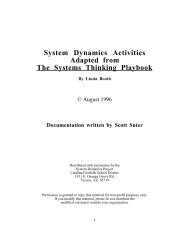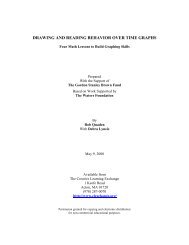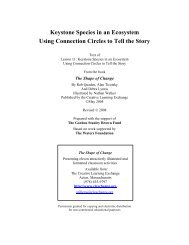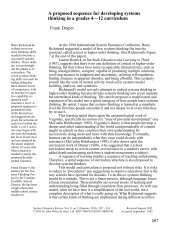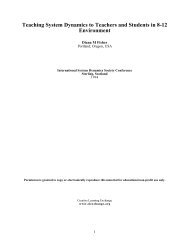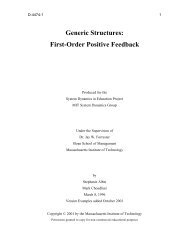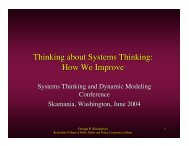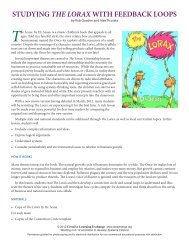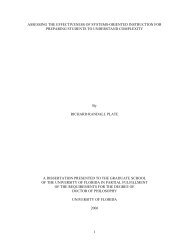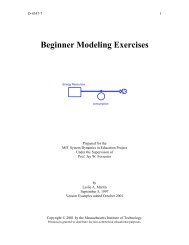Some Basic Concepts in System Dynamics - Creative Learning ...
Some Basic Concepts in System Dynamics - Creative Learning ...
Some Basic Concepts in System Dynamics - Creative Learning ...
Create successful ePaper yourself
Turn your PDF publications into a flip-book with our unique Google optimized e-Paper software.
- 2 - D-4894
- 4 - D-4894
D-4894 - 5 -<strong>Some</strong> <strong>Basic</strong> <strong>Concepts</strong> <strong>in</strong> <strong>System</strong> <strong>Dynamics</strong>byJay W. ForresterIn its full development, system dynamics is a discipl<strong>in</strong>e with the scope ofscience, education, law, eng<strong>in</strong>eer<strong>in</strong>g, or medic<strong>in</strong>e. On the other hand, it isbecom<strong>in</strong>g clear that teachers <strong>in</strong> ord<strong>in</strong>ary K-12 schools can make enough progress<strong>in</strong> two or three years to achieve major improvement <strong>in</strong> students’ th<strong>in</strong>k<strong>in</strong>g, selfreliance, and enthusiasm for learn<strong>in</strong>g.1. THE NATURE OF SYSTEMSMany pr<strong>in</strong>ciples form the foundation of system dynamics and become a basisfor th<strong>in</strong>k<strong>in</strong>g <strong>in</strong> all endeavors.1.1. Feedback LoopsHere we touch on the natureof feedback loops. People seldomrealize the pervasive existence offeedback loops <strong>in</strong> controll<strong>in</strong>geveryth<strong>in</strong>g that changes throughtime. Most people th<strong>in</strong>k <strong>in</strong> l<strong>in</strong>ear,nonfeedback terms. For example,<strong>in</strong> Figure 1, people see a problem,Figure 1decide on an action, expect aresult, and believe that is the endof the issue. Figure 1 illustratesthe framework with<strong>in</strong> which mostdiscussions are debated <strong>in</strong> thepress, bus<strong>in</strong>ess, and government.Copyright © 2009by Jay W. ForresterPermission granted to reproduceFor noncommercial and educational purposes
- 6 - D-4894InformationaboutproblemClosed-loop Structureof the WorldActionFigure 2ResultA-4293JWF34However, a far morerealistic perception would beFigure 2 <strong>in</strong> which a problemleads to action that produces aresult that creates futureproblems and actions. There isno beg<strong>in</strong>n<strong>in</strong>g or end.We live <strong>in</strong> a complex of nestedfeedback loops. Every action,every change <strong>in</strong> nature, is setwith<strong>in</strong> a network of feedbackloops. Feedback loops are thestructures with<strong>in</strong> which allchanges occur.JWF35Fill<strong>in</strong>g a glass of water isnot merely a matter of waterflow<strong>in</strong>g <strong>in</strong>to the glass. There is acontrol of how much water. Thatcontrol is the feedback loop fromwater level to eye to hand tofaucet to water flow and back towater level. Such closed loopscontrol all action everywhere.Figure 3
D-4894 - 7 -1.2. Simplest Feedback LoopFigure 4 shows the simplest possiblefeedback system. In the figure are twosymbols—a stock, and a flow. The stockis an accumulation, or <strong>in</strong>tegration, or level,to choose term<strong>in</strong>ology from differentfields. The flow changes the amount <strong>in</strong> thestock. The flow is determ<strong>in</strong>ed by astatement that tells how the flow iscontrolled by the value of the stock <strong>in</strong>comparison to a goal. All systems,everywhere, consist of these two k<strong>in</strong>ds ofconcepts—stocks and flows—and noneother. Such a statement, that there two andonly two k<strong>in</strong>ds of variables <strong>in</strong> a system, ispowerful <strong>in</strong> simplify<strong>in</strong>g our view of theworld. People familiar with account<strong>in</strong>gstatements, as <strong>in</strong> annual reports ofcorporations, will recognize the twoFigure 4classes of variables. A f<strong>in</strong>ancial report ispresented on two different pages—thebalance sheet and the profit and loss statement. All numbers on the balance sheetare stocks represent<strong>in</strong>g accumulations that have evolved over time. The profit andloss statement represents the flows that cause the stocks to change. There is nocomparably important third page, only the page represent<strong>in</strong>g stocks and the pagerepresent<strong>in</strong>g flows. That structure of an account<strong>in</strong>g statement represents afundamental truth about all systems. Water <strong>in</strong> a bathtub is a stock; the flow ofwater changes the stock. A person’s reputation is a stock that is changed by theflow of good and bad actions by that person. The degree of frustration <strong>in</strong> a groupis a stock that gradually changes <strong>in</strong> response to surround<strong>in</strong>g pressures.2. FROM SIMPLE TO COMPLEX SYSTEMSThe basic feedback loop <strong>in</strong> Figure 4 is too simple to represent real-worldsituations. But simple loops have more serious shortcom<strong>in</strong>gs—they are mislead<strong>in</strong>gand teach the wrong lessons. Most of our <strong>in</strong>tuitive learn<strong>in</strong>g comes from verysimple systems. The truths learned from simple systems are often completely
- 8 - D-4894opposite from the behavior of more complex systems. A person understands fill<strong>in</strong>ga water glass, as <strong>in</strong> Figure 3. But, if we go to a system that is only five times as!JWF037B"#$%&'()complicated, as <strong>in</strong> Figure 5, <strong>in</strong>tuition fails. A person cannot look at Figure 5and anticipate the behavior of the pictured system.Figure 5 from World <strong>Dynamics</strong> is five times more complicated than Figure 4<strong>in</strong> the sense that it has five stocks—the rectangles <strong>in</strong> the figure. The figure showshow rapidly apparent complexity <strong>in</strong>creases as more system stocks are added.Mathematicians would describe Figure 5 as a fifth-order, nonl<strong>in</strong>ear, dynamicsystem. No one can predict the behavior by study<strong>in</strong>g the diagram or its underly<strong>in</strong>g
D-4894 - 9 -equations. Only by us<strong>in</strong>g computer simulation can the implied behavior berevealed.Figure 5 displays <strong>in</strong>teractions between population, capital equipment,agriculture, resources, and pollution. The diagram l<strong>in</strong>ks multiple discipl<strong>in</strong>es. Aproper study of systems must usually break down the boundaries betweenacademic discipl<strong>in</strong>es. As stated by Gordon S. Brown, former dean of eng<strong>in</strong>eer<strong>in</strong>gat MIT, “The message is <strong>in</strong> the feedback, and the feedback is <strong>in</strong>herently<strong>in</strong>terdiscipl<strong>in</strong>ary.”3. EVERYONE USES MODELSI sometimes ask an audience how many use models for all their decisions.No one responds. How then, I ask, do they make decisions? They quickly see thatall decisions are made on the basis of mental models. No one’s head conta<strong>in</strong>s afamily, city, school, country, or bus<strong>in</strong>ess. Decisions are based only on assumptionsabout separate parts of real systems, and try<strong>in</strong>g by <strong>in</strong>tuition to fit those fragmentsof knowledge <strong>in</strong>to an estimate of how th<strong>in</strong>gs change and what will be theconsequences of a proposed action.ModelsAll actions based on modelsMental modelsBasis of human activity.Major strength:Tremendous store of<strong>in</strong>formationMajor weakness:Unreliable <strong>in</strong> handl<strong>in</strong>gcomplexity and dynamicchange.JWF12Figure 63.1. Computer Models andMental Models<strong>System</strong> dynamics builds two-waycommunication between mental modelsand simulation models. Mental modelsare the basis for everyday decisions.Mental models conta<strong>in</strong> tremendousstores of <strong>in</strong>formation. But the humanm<strong>in</strong>d is unreliable <strong>in</strong> understand<strong>in</strong>g whatthe available <strong>in</strong>formation means <strong>in</strong> termsof behavior. Computer simulationmeshes nicely with mental models bytak<strong>in</strong>g the mentally stored <strong>in</strong>formationand then display<strong>in</strong>g the dynamicconsequences.Such mental models belong to the same class as the computer models used<strong>in</strong> system dynamics. In fact a system dynamics model is often built fromassumptions <strong>in</strong> the mental models. Mental models are rich and often sufficiently
- 10 - D-4894Computer SimulationMake mental models explicitDiscover <strong>in</strong>consistenciesDeterm<strong>in</strong>e future implicationsImprove mental modelsaccurate about the pieces of asystem—what <strong>in</strong>formation is available,who is connected to whom, what aredifferent people try<strong>in</strong>g to achieve. Butmental models are entirely unreliable<strong>in</strong> deduc<strong>in</strong>g what behavior will resultfrom the known pieces of a complexsystem. On the other hand, a computersimulation can, without doubt, revealthe behavior implicit <strong>in</strong> the structurefrom which it is constructed.Figure 7JWF154. WORKING WITH COMPUTER MODELSThe translation of a mental model to a system dynamics simulation modelmoves through several stages.1. A model must be created with no logical <strong>in</strong>consistencies.All variables must be def<strong>in</strong>ed. None can be def<strong>in</strong>ed more than once.Equations must be unambiguous. Units of measure should be thesame on both sides of an equation. Most system dynamics softwareapplications check for and f<strong>in</strong>d such logical errors.2. When a model is first simulated, the results may be absurd.Simulated behavior may be impossible. Inventories, or water <strong>in</strong> abathtub, or students <strong>in</strong> the school may go negative; negative valuesoften have no real-world mean<strong>in</strong>g. One goes back to ref<strong>in</strong>e the modeland make the structure more realistic and more robust.3. As a model becomes better, surpris<strong>in</strong>g behavior often doesnot reveal model errors but <strong>in</strong>stead beg<strong>in</strong>s to tell someth<strong>in</strong>g about reallife that was not previously realized. I have usually had such new<strong>in</strong>sights from models. One example arose from the model <strong>in</strong> myUrban <strong>Dynamics</strong> book deal<strong>in</strong>g with the growth and stagnation <strong>in</strong>cities. One weekend I added a job-tra<strong>in</strong><strong>in</strong>g program to the model. Itwas a perfect job-tra<strong>in</strong><strong>in</strong>g program <strong>in</strong> the sense that it simply tookpeople out of the unskilled and underemployed category and put them
D-4894 - 11 -<strong>in</strong> skilled labor; and, furthermore, no charge was assigned so it costnoth<strong>in</strong>g.The perfect job-tra<strong>in</strong><strong>in</strong>g program caused unemployment <strong>in</strong> themodel to go up. The <strong>in</strong>crease <strong>in</strong> unemployment surprised me until Ispent a day discover<strong>in</strong>g what the model was do<strong>in</strong>g, after which theresult seemed plausible. I took the computer runs back to formermayor John Coll<strong>in</strong>s and the several people from Boston bus<strong>in</strong>ess andpolitics that had been work<strong>in</strong>g with me. They looked at the ris<strong>in</strong>gunemployment as a result of <strong>in</strong>troduc<strong>in</strong>g job tra<strong>in</strong><strong>in</strong>g <strong>in</strong> silence forseveral m<strong>in</strong>utes until one said, “Oh, Detroit has the best job-tra<strong>in</strong><strong>in</strong>gprogram <strong>in</strong> the country and the most rapidly ris<strong>in</strong>g unemploymentrate!” Later I went to people <strong>in</strong> the bus<strong>in</strong>ess of runn<strong>in</strong>g job-tra<strong>in</strong><strong>in</strong>gprograms and asked if they had ever heard of a situation where jobtra<strong>in</strong><strong>in</strong>g could <strong>in</strong>crease unemployment. Their answer, “Of course,when that happens we go to another city.”The job-tra<strong>in</strong><strong>in</strong>g program <strong>in</strong> the model was defeated by threeforces: 1) before the program, bus<strong>in</strong>esses had been dipp<strong>in</strong>g <strong>in</strong>to theunskilled and unemployed pool as necessary to obta<strong>in</strong> employees.The job-tra<strong>in</strong><strong>in</strong>g program substituted for the tra<strong>in</strong><strong>in</strong>g that bus<strong>in</strong>esseswould have done, so tra<strong>in</strong><strong>in</strong>g by bus<strong>in</strong>esses stopped. About half of thetra<strong>in</strong><strong>in</strong>g program was neutralized by such substitution; 2) the program<strong>in</strong>creased the number of skilled workers thereby <strong>in</strong>creas<strong>in</strong>gunemployment among skilled workers and resulted <strong>in</strong> <strong>in</strong>creaseddownward flow back to the unskilled-unemployed pool. Nearlyanother half of the tra<strong>in</strong><strong>in</strong>g was lost through the <strong>in</strong>creased downwardmobility; 3) and last, the tra<strong>in</strong><strong>in</strong>g program had high public visibilityand attracted unemployed from other cities, even though the programhad not created significant new jobs. Forces with<strong>in</strong> the systemneutralized the tra<strong>in</strong><strong>in</strong>g program and the public visibility of theprogram attracted additional people who would <strong>in</strong>crease unemployed.Another situation of first learn<strong>in</strong>g about real life from a simulation modelarose when a student modeled the behavior of <strong>in</strong>sul<strong>in</strong> and glucose <strong>in</strong> variousaspects of diabetes. In response to an experiment simulated with<strong>in</strong> the model, hegot a result from his computer patient that had never been reported <strong>in</strong> the medicalliterature. Was there someth<strong>in</strong>g wrong with the model? He showed the results todoctors do<strong>in</strong>g diabetes research. After study<strong>in</strong>g what was happen<strong>in</strong>g <strong>in</strong> the model,their response was, “We had a patient like that once, but always thought there was
- 12 - D-4894a mistake <strong>in</strong> the measurements.” This process had identified a new medicalsyndrome.5. SOURCES OF INFORMATIONMentaldata baseConsider the available databases,or sources of <strong>in</strong>formation from whichwe can build computer simulationmodels.JWF13Writtendata baseNumericaldata baseSources of InformationFigure 8I suggest that the world’s storeof <strong>in</strong>formation lies primarily <strong>in</strong>people’s heads—the mental database.As a test of that statement, considerany <strong>in</strong>stitution, for example, yourcorporation or your school system.Imag<strong>in</strong>e that at 10 o’clock somemorn<strong>in</strong>g every person suddenly leavesand is replaced by a person who canread but has no experience <strong>in</strong> thesystem. You <strong>in</strong>struct your replacementto follow the <strong>in</strong>structions and policystatements <strong>in</strong> your office and carry onfor you. Chaos would result. Ourfamilies, schools, bus<strong>in</strong>esses andcountries operate on the <strong>in</strong>formation <strong>in</strong>people’s heads ga<strong>in</strong>ed from participation, apprenticeship, and on-the-job learn<strong>in</strong>g.The mental database is vastly richer than the written database <strong>in</strong> the form of books,magaz<strong>in</strong>es, and newspapers. In turn, the written database is far more <strong>in</strong>formativeabout how society operates than the numerically recorded <strong>in</strong>formation.<strong>System</strong> dynamics model<strong>in</strong>g should build on all available <strong>in</strong>formation,<strong>in</strong>clud<strong>in</strong>g the volum<strong>in</strong>ous mental database. By contrast, most analyses <strong>in</strong> the socialsciences have been limited to <strong>in</strong>formation that has been numerically recorded. Thenumerical <strong>in</strong>formation is an extremely small part of all the <strong>in</strong>formation that isavailable.
D-4894 - 13 -6. GENERIC OR TRANSFERABLE STRUCTURESGeneric StructuresTransferable between:Past and presentFrom one sett<strong>in</strong>g to anotherA small number cover a widerange ofsituationsWhen understood <strong>in</strong> one sett<strong>in</strong>g,they are understood <strong>in</strong> allsett<strong>in</strong>gsBasis for effective educationJWF7Many structures of levelsand rates are found repeatedly.They are “generic structures”because they are found <strong>in</strong> manydifferent situations, even <strong>in</strong>entirely different fields ofapplication. If a particularstructure is understood <strong>in</strong> onesett<strong>in</strong>g, it is understood <strong>in</strong> allsett<strong>in</strong>gs. Generic structuresprovide a person with power tomove between situations with thelearn<strong>in</strong>g <strong>in</strong> one area be<strong>in</strong>g appliedto other situations.Figure 9In education, afterunderstand<strong>in</strong>g a collection of basicdynamic structures, a student canquickly draw on one to understanda new situation if its structure hasbeen encountered previously.
- 14 - D-48946.1. Generic Structure of a Clock and Economic Bus<strong>in</strong>ess CycleVelocityEmploymentChange <strong>in</strong>positionProductionrate less salesAccelerationHir<strong>in</strong>g rateFigure 10PositionInventoryA-3865Ad.5JWF39Figure 10shows two sets ofnomenclature. Thelabels above thebars relate to thesw<strong>in</strong>g<strong>in</strong>g pendulumof a clock. Thelabels below thebars describe<strong>in</strong>ventory andemployment <strong>in</strong>manufactur<strong>in</strong>g.With appropriatechoices of parametervalues, the structurewill exhibit theoscillation of a onesecondclock pendulum, or alternatively the several-year <strong>in</strong>terval between peaks ofa bus<strong>in</strong>ess cycle. The s<strong>in</strong>gle loop with two levels as <strong>in</strong> Figure 10 results <strong>in</strong> only asusta<strong>in</strong>ed oscillation. Additional structure is necessary to represent friction <strong>in</strong> apendulum or the forces that might change the amplitude of bus<strong>in</strong>ess cycles. Asw<strong>in</strong>g<strong>in</strong>g pendulum and the central core of the production-<strong>in</strong>ventory bus<strong>in</strong>ess cyclehave the same oscillatory structure.In my own experience with transferability of structure, I was meet<strong>in</strong>g with agroup of medical doctors and pharmacologists <strong>in</strong> Palo Alto one day. A topic cameup that was not on the agenda. They began to talk about a doctor who was do<strong>in</strong>gan experimental treatment, which clearly those present did not approve. They haddescribed the experiment but had said noth<strong>in</strong>g of the results when I suggested anoutcome. I told them that if I were to judge that medical experiment on the basisof the k<strong>in</strong>d of behavior that we had seen <strong>in</strong> the Urban <strong>Dynamics</strong> model of cities, Iwould guess the treatment would cause atrophy of the pancreas. They said,“You’re right. That’s exactly what’s happen<strong>in</strong>g.” There was enough
D-4894 - 15 -transferability of structure between the two systems to justify suggest<strong>in</strong>g themedical outcome.For dramatic, personal-experience learn<strong>in</strong>g, computer structures can beconverted <strong>in</strong>to games with people mak<strong>in</strong>g the decisions that would control theflows <strong>in</strong> a model. A distribution system from manufacturer, through distributorand retailer, to customers has been played by hundreds of thousands of peoplearound the world to drive home the way <strong>in</strong> which people can <strong>in</strong>teract to create<strong>in</strong>stability. Other games show the dynamics of produc<strong>in</strong>g great depressions some45 to 80 years apart, and still others show how companies can grow so rapidly thatthey cause their own failure.7. DIFFERENTIAL EQUATIONS VS. INTEGRATIONOne might ask how it is now possible to teach behavior of complex dynamicsystems <strong>in</strong> K-12 when the subject has usually been reserved for college andgraduate schools. The answer lies <strong>in</strong> hav<strong>in</strong>g realized that the mathematics ofdifferential equations has been stand<strong>in</strong>g <strong>in</strong> the way.Differential equations are difficult, confus<strong>in</strong>g, weak, and unrealistic. Theyoften mislead students as to the nature of systems. Mathematicians have haddifficulty def<strong>in</strong><strong>in</strong>g a derivative and there is a reason. Derivatives do not existexcept <strong>in</strong> a mathematician’s imag<strong>in</strong>ation. Nowhere <strong>in</strong> nature does nature take aderivative. Nature only <strong>in</strong>tegrates, that is, accumulates <strong>in</strong> stocks. Cast<strong>in</strong>g behavior<strong>in</strong> terms of differential equations leaves many students with an ambiguous or evenreversed sense of the direction of causality. I have had MIT students argue thatwater flows out of the faucet because the level of water <strong>in</strong> the glass is ris<strong>in</strong>g; thatseems natural to them if the flow has been def<strong>in</strong>ed as the derivative of the waterlevel <strong>in</strong> the glass.Any child who can fill a water glass or take toys from a playmate knowswhat accumulation means. The stocks <strong>in</strong> a system dynamics model (the rectangles<strong>in</strong> Figures 4 and 5) are the <strong>in</strong>tegrations (accumulations). By approach<strong>in</strong>g dynamicsthrough the w<strong>in</strong>dow of accumulation, students can deal with high-order dynamicsystems without ever discover<strong>in</strong>g that their elders consider such to be verydifficult.
- 16 - D-4894An MIT undergraduate work<strong>in</strong>g to develop system dynamics materials forK-12 education observed:In my differential equations class we used calculus to figure out thebehavior of populations. I realized just how much simpler system dynamicsmade that thought process. Whereas only college students can understandsuch phenomena us<strong>in</strong>g math, elementary scholars can understand the sameth<strong>in</strong>gs by us<strong>in</strong>g system dynamics model<strong>in</strong>g. It’s really amaz<strong>in</strong>g.”This paper has given only a glimpse of the pr<strong>in</strong>ciples and concepts that makeup an understand<strong>in</strong>g of complex social and economic systems. Furthermore, anunderstand<strong>in</strong>g of systems will not be <strong>in</strong>ternalized just by read<strong>in</strong>g about them. Welook forward to the time when an education from k<strong>in</strong>dergarten through college willcreate citizens and leaders who can create far more satisfactory human andenvironmental systems.8. MORE ON SYSTEM DYNAMICSStudy materials are available from the <strong>Creative</strong> Learn<strong>in</strong>g Exchange. Manydownloads of the K-12 <strong>in</strong>formation come from corporations that use the materialfor <strong>in</strong>ternal tra<strong>in</strong><strong>in</strong>g. Exactly the same material can be used anywhere from the 5 thgrade to chief executive officers; it is new to all.<strong>Creative</strong> Learn<strong>in</strong>g Exchangehttp://clexchange.orgMs. Lees Stuntz, Director27 Central StreetActon, MA 01720tel: 978-635-9797fax: 978-635-3737email: stuntzln@clexchange.orgLook on the web site or ask about the list of available materials to bedownloaded and the “Road Maps,” which is a self-study <strong>in</strong>troduction to systemdynamics. Also go to:sysdyn.clexchange.orgfor the assignments and solutions for the Guided Study Program <strong>in</strong> <strong>System</strong><strong>Dynamics</strong>Internet discussion group: Send a message tolistserv@sysdyn.clexchange.org with the l<strong>in</strong>e “subscribe k-12sd first-name last-
D-4894 - 17 -name” as the only th<strong>in</strong>g <strong>in</strong> the message’s body (no footer, no signature, etc.) Thesubject l<strong>in</strong>e is immaterial. “First-name” and “last-name” are your first and lastnames.Pegasus Communications, Inc.One Moody StreetWaltham, MA 02453-5339tel: 781-398-9700fax: 781-894-7026Alfeld, Louis Edward, and Alan K. Graham. 1976. Introduction to Urban <strong>Dynamics</strong>. Waltham,MA: Pegasus Communications. 333 pp.Fisher, Diana M. 2001. Lessons <strong>in</strong> Mathematics: A Dynamic Approach. Lebanon, NH: isee<strong>System</strong>s.Fisher, Diana M. 2004. Model<strong>in</strong>g Dynamic <strong>System</strong>s: Lessons for a First Course. Lebanon, NH:isee <strong>System</strong>s.Forrester, Jay W. 1961. Industrial <strong>Dynamics</strong>. Waltham, MA: Pegasus Communications. 464 pp.Forrester, Jay W. 1968. Pr<strong>in</strong>ciples of <strong>System</strong>s. (2 nd ed.). Waltham, MA: PegasusCommunications. 391 pp.Forrester, Jay W. 1969. Urban <strong>Dynamics</strong>. Waltham, MA: Pegasus Communications. 285 pp.Forrester, Jay W. 1971. World <strong>Dynamics</strong>. (1973 second ed.). Waltham, MA: PegasusCommunications. 144 pp. Second edition has an added chapter on physical vs. social limits.Forrester, Jay W. 1975. Collected Papers of Jay W. Forrester. Waltham, MA: PegasusCommunications. 284 pp.Goodman, Michael R. 1974. Study Notes <strong>in</strong> <strong>System</strong> <strong>Dynamics</strong>. Waltham, MA: PegasusCommunications. 388 pp.Mass, Nathaniel J., ed., 1974. Read<strong>in</strong>gs <strong>in</strong> Urban <strong>Dynamics</strong>: Volume I, Waltham, MA: PegasusCommunications, 303 pp.Meadows, Dennis L. 1970. <strong>Dynamics</strong> of Commodity Production Cycles. Waltham, MA: PegasusCommunications. 104 pp.Meadows, Dennis L., et al. 1974. <strong>Dynamics</strong> of Growth <strong>in</strong> a F<strong>in</strong>ite World. Waltham, MA:Pegasus Communications. 637 pp.Meadows, Dennis L., and Donella H. Meadows, ed., 1973. Toward Global Equilibrium:Collected Papers, Waltham, MA: Pegasus Communications, 358 pp.Randers, Jorgen, ed., 1980. Elements of the <strong>System</strong> <strong>Dynamics</strong> Method, Waltham, MA: PegasusCommunications, 488 pp.Richardson, G. P. (1991). Feedback Thought <strong>in</strong> Social Science and <strong>System</strong>s Theory. Waltham,MA: Pegasus Communications.Schroeder, Walter W., III, Robert E. Sweeney, and Louis Edward Alfeld, ed., 1975. Read<strong>in</strong>gs <strong>in</strong>Urban <strong>Dynamics</strong>: Volume 2, Waltham, MA: Pegasus Communications, 305 pp.



